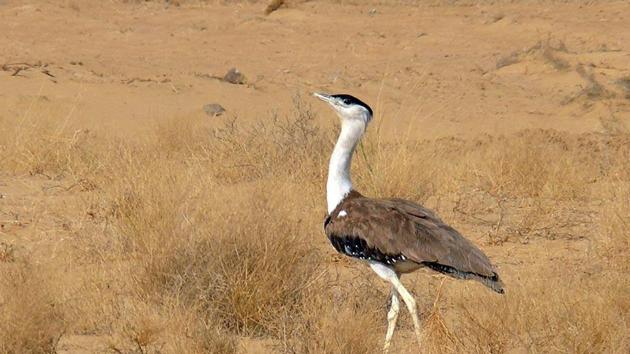Search for the endangered Great Indian Bustard fails to find any in Maharashtra
Studies have shown that there are at present around 250 GIBs in different parts of the country/.
A survey conducted by the Wildlife Institute of India (WII), Dehradun, across 11 districts in Maharashtra, did not record a single Great Indian Bustard (GIB), which is listed as a critically endangered species by the International Union for Conservation of Nature.

However, scientists who conducted the survey between September 25 and September 30 last year, said the finding may not imply that the bird is extinct in the state. Though the survey team did not record any of the species, 72 of the 1401 residents who were surveyed through a questionnaire, confirmed the presence of GIBs in their area in a time span ranging from September 20 and September 24 to the previous six months.
The report, titled Status of Great Indian Bustard and Associated Species in Maharashtra, which was released this month has estimated that the state is home to less than eight GIBs. Studies so far have estimated the presence of 8-10 GIBs in the state.
“GIB will be the first bird to go extinct in our lifetime, and it could happen in a decade. Less than eight birds in Maharashtra is quite disastrous. There are various estimates but none that is higher than 200 in the country. My personal estimate is as low as 50-100,” said Bikram Grewal, Delhi-based ornithologist, who was not involved in the survey.
Grewal added, “Other than doing lip service, no one is interested whether it goes or comes. There is apathy, and no will to save it because the government thinks that the environment comes in the way of the nation’s progress.”
The report has identified 11 clusters across 12 forest divisions, covering an area of 12,528sq kms as being important to protect and conserve GIBs in the state. Much of these areas are dominated by kharif crop fields that are foraging grounds for GIBs. One of the important recommendations to conserve the GIB in the state is to promote and incentivise traditional cropping.
In the potential GIB habitats, the survey recorded 238 groups of blackbucks with a total population of around 37,690; and 19 groups of Chinkara with a total population of around 1,481.
“There are two issues with GIBs. Firstly, their numbers are already very low; secondly, their range of distribution is very large. So the probability of detecting the bird is extremely low,” said Bilal Habib, principal investigator, and scientist at the department of animal ecology and conservation biology, WII. “But it’s important to understand that not being able to detect the bird does not mean that there is no bird.”
The report has recommended that the 11 clusters must be rigorously monitored at least 2-3 times a year for 1-2 years. The idea being that even if a GIB cannot be spotted, conserving these clusters will protect the bird by default.
“There is a need to put reflectors on power lines in such areas. Measures should be taken to monitor and control the growth of dog populations in such area,” stated the report.
BOX
Studies have shown that there are at present around 250 GIBs in different parts of the country with the maximum population of 100-150 in Rajasthan.
In 2015, BirdLife International estimated that there are 35 spread across Maharashtra, Gujarat, Madhya Pradesh and Andhra Pradesh.
The bird is listed under Schedule 1 species as per Wildlife (Protection) Act 1972, and listed as endangered or Appendix 1 species of the Convention on International Trade in Endangered Species.
GIB is a very slow-breeding bird. Once a female GIB hatches an egg, it will stay with the young one for the next two years, and won’t hatch another egg. So if there are two female GIBs, there will be only two offsprings in two years.
Other recommendations:
Forest department-owned areas within the identified grids should be managed as bustard habitats by removing invasive species.
There is an urgent need for awareness in these identified clusters with option to promote traditional cropping patterns. Any changes in these areas will be critical for GIB conservation.



